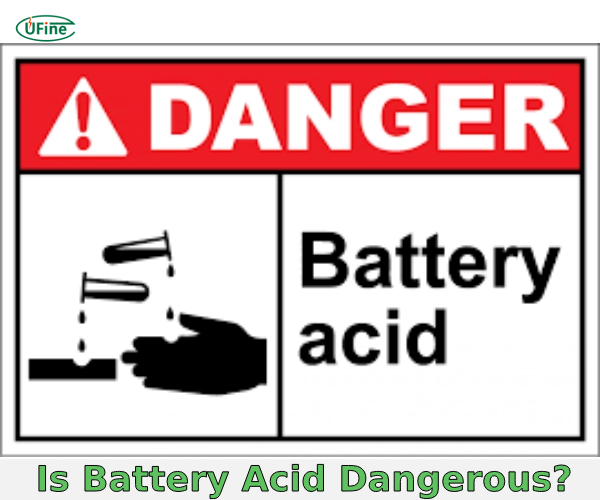Safety should always be a top priority when it comes to batteries, particularly those that contain acid. Battery acid, or electrolyte, can pose risks if mishandled or improperly stored. In this comprehensive guide, we will explore the different types of batteries that contain acid and the associated risks and provide essential information on safe handling, storage, and first aid measures for battery acid exposure.
Part 1. Types of batteries containing acid
Battery acid is commonly found in different types of batteries, each with its specific uses and characteristics. The most common types include:
- Lead-Acid Batteries: These batteries typically power cars, trucks, motorcycles, and other vehicles. They contain sulfuric acid, which is highly corrosive and can cause severe burns if not handled properly.
- Nickel-Cadmium (NiCd) Batteries: Often used in power tools, toys, and rechargeable devices, NiCd batteries contain a mixture of potassium hydroxide and cadmium, which can be harmful if leaked.
- Nickel-Metal Hydride (NiMH) Batteries: Similar to NiCd batteries, manufacturers commonly use NiMH batteries in digital cameras, laptops, and other electronic devices. They contain a potassium hydroxide electrolyte and are less toxic than NiCd batteries.
- Lithium-Ion (Li-ion) Batteries: Widely used in smartphones, tablets, and laptops, Li-ion batteries contain lithium salt electrolytes. While they don’t typically contain free-flowing acid like lead-acid batteries, they can still pose risks if damaged or punctured, leading to chemical leakage.
- Alkaline Batteries: These are the standard household batteries used in remote controls, flashlights, and other electronic devices. They contain potassium hydroxide electrolytes, which are less corrosive than sulfuric acid but can still irritate if leaked.
Part 2. Risks associated with battery acid
Understanding the potential risks of battery acid exposure is essential for implementing effective safety measures. Here are some significant risks to be aware of:
Corrosive Burns:
Battery acid, often sulfuric acid in lead-acid batteries, is highly corrosive. Direct contact with the skin can result in severe burns, leading to pain, irritation, and tissue damage. Prompt rinsing with water is crucial to mitigate the effects of acid exposure.
Chemical Inhalation:
Releasing acid vapors can pose inhalation hazards when batteries are damaged or mishandled. Breathing in these fumes can irritate the respiratory tract, causing coughing, shortness of breath, and throat irritation. Adequate ventilation is vital when working with batteries to minimize exposure to harmful gases.
Environmental Contamination:
Improper disposal of batteries can lead to environmental contamination. Acid leakage from discarded batteries can seep into soil and water sources, endangering ecosystems and wildlife. Recycling batteries through designated facilities is essential to prevent environmental harm.
Fire and Explosion:
Certain battery types, such as lithium-ion batteries, risk fire and explosion if damaged or improperly handled. Internal short circuits or overcharging can trigger thermal runaway, releasing flammable gases and ignition. Proper storage, handling, and charging procedures are critical to mitigate these risks.
Toxic Exposure:
Batteries containing heavy metals like cadmium risk toxic exposure if someone breaches the battery casing. Direct contact with these metals can lead to poisoning symptoms, including nausea, vomiting, and neurological disorders. Proper handling and disposal practices are necessary to minimize the risk of toxic exposure. Associated with Battery Acid
Part 3. Safe handling and storage of battery acid
Wear Protective Gear:
Always wear appropriate personal protective equipment, including gloves, safety goggles, and protective clothing when handling battery acid. This helps prevent direct contact with the acid and minimizes the risk of skin burns or eye irritation.
Ventilation:
Perform battery maintenance and handling tasks in well-ventilated areas to reduce the buildup of acid vapors. Good ventilation helps dissipate harmful gases and minimizes the risk of inhalation hazards.
Avoid Mixing:
Never mix different types of batteries or battery acid. Each battery type requires specific handling procedures, and combining them can lead to chemical reactions, leaks, or even explosions. Keep batteries and acid separated to prevent accidents.
Avoid Skin Contact:
Avoid direct skin contact with battery acid in case of accidental spills or leaks. If contact occurs, immediately rinse the affected area with plenty of water for at least 15 minutes and seek medical attention if irritation persists.
Handle with Care:
When moving or transporting batteries containing acid, exercise caution to prevent spills or damage to the battery casing. Use appropriate lifting techniques and avoid dropping or mishandling batteries to minimize the risk of acid leakage.
Store in Acid-Resistant Containers:
Store battery acid in tightly sealed, acid-resistant containers of materials such as polyethylene or polypropylene. You should label these containers clearly and store them in a cool, dry, well-ventilated area away from direct sunlight and heat sources.
Keep Away from Ignition Sources:
Avoid storing battery acid near open flames, sparks, or ignition sources, as it can react violently and pose fire hazards. Store batteries in a dedicated storage area away from flammable materials to minimize the risk of fire or explosion.
Clean Spills Promptly:
In the event of a spill, immediately neutralize the acid with a suitable alkaline substance, such as baking soda or an acid spill kit. Wear protective gear and carefully contain and clean up the spill to prevent further exposure or environmental contamination.
Dispose of Properly:
When disposing of used batteries or battery acid, follow local regulations and guidelines for hazardous waste disposal. Many communities have designated drop-off locations or recycling centers for safe disposal of batteries to prevent environmental contamination.
Part 4. First aid measures for battery acid exposure
In the event of battery acid exposure, prompt action is crucial to minimize the risk of injury. Follow these first aid measures to provide immediate assistance:
Skin Contact:
- Quickly remove any contaminated clothing and rinse the affected area with lukewarm water for at least 15 minutes.
- Avoid using hot water, as it can further damage the skin.
- If available, gently wash the area with mild soap to remove any remaining acid residue.
- Cover the affected area with a clean, dry dressing or bandage to protect it from further contamination.
Eye Contact:
- Immediately flush the affected eye with lukewarm water for at least 15 minutes, ensuring the eyelid is held open for thorough rinsing.
- Seek medical attention immediately, even if symptoms appear minor, as eye injuries from battery acid can be severe.
Inhalation:
- If you inhale battery acid fumes, move to a well-ventilated area with fresh air.
- If breathing difficulties persist, seek medical attention immediately.
Ingestion:
- If someone ingests battery acid, do not induce vomiting unless instructed by medical professionals.
- Rinse the mouth with water and drink milk or water to help dilute the acid.
- Seek medical attention immediately, as ingesting battery acid can cause serious internal injuries.
Seek Medical Attention:
- Regardless of the severity of exposure, seek medical attention promptly after administering first aid.
- Provide medical professionals with information about the type of battery acid involved and the extent of exposure for appropriate treatment.
Do Not Delay:
- Do not delay seeking medical assistance, even if symptoms initially appear mild.
- Battery acid exposure can cause delayed effects, and early intervention is crucial to prevent complications.
Part 5. FAQs
-
Can dry battery acid hurt you?
Yes, dry battery acid can hurt you if it comes into contact with your skin or eyes. -
Is the liquid inside a battery dangerous?
The liquid inside a battery can be dangerous, especially if it leaks or spills. -
What do you do if battery acid gets on the skin?
If battery acid gets on your skin, you should immediately rinse the affected area with plenty of lukewarm water for at least 15 minutes. -
Can battery acid be washed off?
You can wash off battery acid by rinsing the affected area with water. However, thoroughly washing it off is essential to prevent further skin irritation. -
What neutralizes battery acid?
Baking soda, sodium bicarbonate, is commonly used to neutralize battery acid. Sprinkle baking soda onto the affected area and rinse it with water.
Related Tags:
More Articles

LiPo Battery Discharge Rate Guide & Calculation Tips
Understand LiPo battery discharge rates, C-ratings, and how to calculate max current. Essential guide for RC, drones, and electronics users.
High‑Capacity 3S LiPo Batteries: 5000 mAh vs. 10000 mAh
Compare 3S LiPo 5000mAh vs 10000mAh batteries by weight, power, and use. Find the best fit for your drone, RC car, or boat setup.
Top 5 Applications for Small 3S LiPo Batteries
Small 3S LiPo batteries power drones, RC gear, wearables, and robotics with high energy and low weight. Making them ideal for compact electronics projects.
Building and Charging Your Own 3S LiPo Pack: A Step‑by‑Step Guide
Learn how to build, balance, and charge a 3S LiPo battery pack safely at home with this complete DIY guide for hobbyists and beginners.
How to Choose the Right LiPo Battery Plug Type?
Discover the best LiPo battery plug types, how to choose them, and expert tips for safe usage, soldering, and maintenance.




